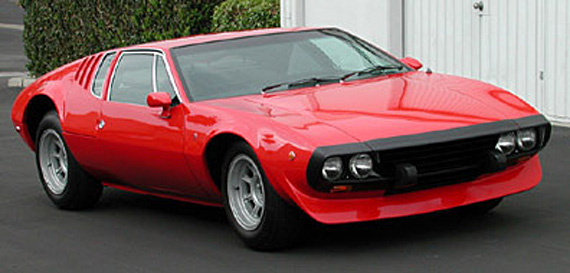
The Bordinat Mangusta had a rubber tipped nose, probably a hint at a bumper that would keep the body lines and still absorb energy, since laws about energy absorbing bumpers were coming up. Ironically Pininfarina’s GTC/4 used the same idea in the production car, introduced in 1971.
By Wallace Wyss
Detroit auto executives are sometimes enthusiasts, though usually they are quite happy to merely be given a new car, or leased one on a super deal, every few months. They like to spend their big bonuses on hunting lodges, cruisers and the like. The ones who own their own special cars are fondly remembered by car enthusiasts as being real car guys. That would include William L. Mitchell, former VP of Design at GM, who went so far as to have cars custom built for him by Design. A less well known enthusiast who was active in creating special cars for himself at the same time is the late Eugene Bordinat of Ford, who was born in 1920, worked for GM before moving to Ford in 1947. He was styling director during the go-go Sixties when Ford turned on the cash funnel to fund racing in every type of motorsport, from Indy racing to drag racing and ended up spending $10 million to win Le Mans, which they did for four years running in 1966 through 1969.
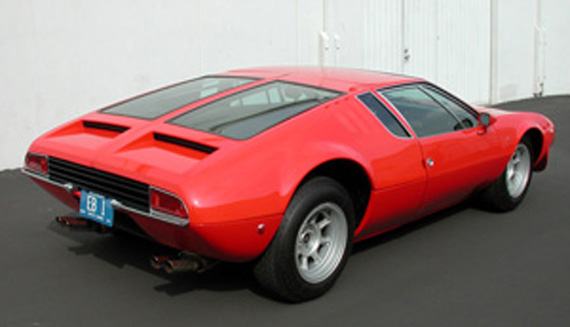
The rear shows different treatment of the rear valance, in this case horizontal bars instead of the chain mail grid that the production Mangustas use. No doubt the production version allowed more cooling air in. Bordinat’s car was probably a pre-production Mangusta.
The Urge to Go Italian
During the time Ford was running at Le Mans, Henry Ford II, grandson of the first Henry Ford, was CEO of the firm and a car enthusiast in his own right. He was married to a fiery Italian, Cristina Vettore, and at one point is said to have given her a Maserati Ghibli coupe. Her comment was to point at the Ghia badge on the side and say something to the effect of Ford could never build anything as classy as the Italians.
Well, that was like prodding HFII with a fiery brand and the next thing you know he is telling his minions to go out and buy Ghia, the carrozzeria that designed the Ghibli.
Actually Ford had tried as far back as the early Sixties to buy an Italian automaker, only that time it was Ferrari. But the deal fell through after two weeks of intense negotiation, some say because Enzo Ferrari didn’t want that Ford oval on his cars next to his proud prancing horse. He sold out the production car side of his operation in 1969 to Fiat.
Bordinat Enters
When HFII put pressure on to find an Italian car builder with a classy name, Bordinat thought of Ghia which had already built previous Ford show cars such as the Futura which became, in its old age, the Batmobile.
Bordinat bought a Mangusta, and titled it under his own name. He championed the idea that Ford bring the Mangusta to the U.S. But after Ford sent two designers to inspect the Ghia facilities, the bad news came back that the car was built in an uneven inconsistent manner that required way too much hand work. Plus the press in the U.S., particularly Sports Car Graphic, was roasting the Mangusta for its squirrely handling.
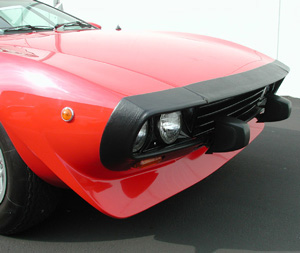
The rubber bumper guards were added by Bordinat’s styling crew in a further attempt at making a 5-mph bumper. But the Mangusta , designed in 1966, just didn’t adapt to bumper laws easily. But the main reason it was nixed was that, after Ford engineers and designers inspected the assembly line, it was judged too hand built to be built in the quantities Ford would need it built.
Back to the Ghia deal. In Italy, Alessandro de Tomaso, a former race driver turned car builder in 1959, had somehow become head of Ghia Carrozzeria. He had the most talented designer in Italy, Giorgetto Giugiaro, on the drawing board and Giugiaro came up with a beautiful mid-engine car design for a company called Iso.
But it was done on spec, Giugiaro and Iso engineer Giotto Bizzarrini hoping Iso owner Renzo Rivolta would go for the idea of a sports car companion for the Giugiaro-designed Iso Fidia four-door with similar styling cues. But Rivolta didn’t want it. So DeTomaso thought it was a shame to throw away particularly when it was just right for a chassis he had sitting around from a race car project that went sour that he had going with Carroll Shelby. The result was the exciting Mangusta show car.
[Is the above paragraph true? Might any of our readers know the story behind the design that Giugiaro submitted to Rivolta? Ed.]
Bordinat got as far as fitting his own Mangusta with a rubber nose similar to the Ferrari 365GTC/4 and big bumper guards that might have got it past the upcoming 5-mph front bumper regulations. His own car also has a different grating in the rear, and once had white sidewall wheels.
Ironically the aforementioned William L. Mitchell also went ga-ga over the Goose and ordered one for himself, insisting it have a Chevy engine installed in place of the meek and mild Windsor 302 Ford V8. He got the car and tried to squeeze in it, but as he was a man of considerable girth, he couldn’t fit, and angrily ordered the car sold. A lucky GM designer, Dick Ruzzin, ended up with the car and has prized it ever since.
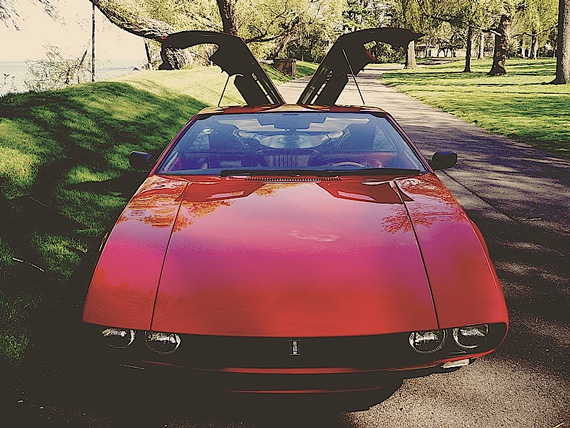
Dick Ruzzin’s ex Mitchell Mangusta with the Chevy engine. More to come from Ruzzin so stay tuned! Photo by Dick Ruzzin.
But as history records, Ford went thumbs down on the Mangusta and instead ordered up over 6,000 Panteras though all Ghia could show them of the Mangustas planned successor was a one-fifth scale wood model. It turned out the Pantera had teething troubles as well, but the enthusiastic owners have solved them all, and they are more popular today than they were in their original era.
The interior is basically stock, though at least it has the later Mangusta air con vents in the dash where some had a clumsy air conditioning box underneath the dash. The wood and leather steering wheel was way ahead of its time, with some luxury cars using that today. The radio speakers in the console are aftermarket.
Ford buys Ghia
So Ford bought the Pantera, and bought Ghia, and even got another old name in coachbuilding, Vignale, thrown in with the deal. They then used Ghia from 1969 to the present day to build prototypes for them, many many prototypes, some of which were sold at an auction in Dearborn.
More important they got bragging rights to use the Ghia badge on any Ford that had been blessed with Ghia labors, such as the Cortina, Granada, dozens of models. In fact they so overused the name Ghia in the U.S. that they stopped using it because they had de-valued it and may be planning to re-introduce it if they can restore its image.
The Mangusta Fleet
Of the 401 Mangusta reported to have been built, there are approximately 300 left. They are not cars you can easily drive everyday, being so low to the ground that it is easy to crack the precious transaxle case on a speed bump. But they are spectacular cars to drive on a Sunday afternoon, and still turn heads. One, the one-off spider built for the Turin Show, has even graced the lawn at the prestigious Pebble Beach concours, while Panteras are still not allowed there because they are, after all, too common to compete in such rarefied an atmosphere.
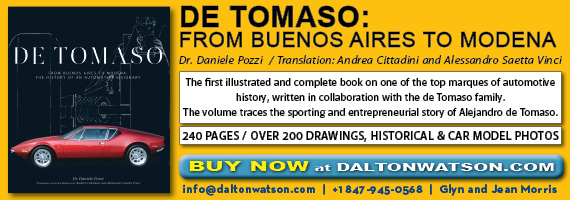
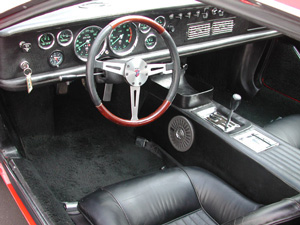
There is yet another GM designer that has just finished restoring his gorgeous
Mangusta, George Anderson (Michigan Area).
Thank you Wallace, nice article .
This Mangusta, #1196 was owned by E. Bordinate and the Ford Company referred to this prototype as the Bordinat Mangusta Ghia, they as many others had issues with DeTomaso’s way of doing business. The removable front body cover does look like rubber but it is leatherette. She now has only 4, 400. miles and was invited to be shown at Amelia Island this March. Her 1974 paint job has held up fantastically.
we had 3 of these lovelies on our showroom floor at the same time; one pale blue with pale leather, one pale green with black, and a metallic dark gray with pigskin. they had a perhaps unintentional rev limiter: at about 5100rpm the points would float. on the road they gave great mileage, but i can’t remember the number exactly. the front brakes would lock up very easily in the rain; i heard someone cut off half the brake pads to help that situation a bit.
What a great car! There is at least onze of these in Holland, saw iT juist a few weeks ago at an auction. To much money for my wallet…
Anyone remember designer Larry Nicklin? I sold him my Mangusta in the late 80’s. He drove back to Leo, Indiana from Wisconsin. He called when he arrived home and said,”what a great car, had it up to 125 on the Indiana Tollway”.
#8MA902
I have a wonderful rendering of a Bugatti that he painted that I would like to get to someone in his family.
bill@wschley.com
Another designer with a Mangusta was the late Herb Grasse – of Batmobile & Bricklin fame. It was previously owned by Cassius Clay/ Muhammad Ali. Herb brought the blue Mangusta to Australia with him, when he joined Ford Australia at the invitation of his Friend Andy Jacobson, who was Chief Designer of Ford Australia at the time. The car wasn’t very practical in Australia – apart from ground clearance, the rose jointed suspension wasn’t really robust or comfortable enough for Australian Roads. The car was metallic blue in colour – I don’t know what happened to it after Herb sold it – hopefully it is still in Australia somewhere. PS – Herb bought my Lamborghini Miura from me – after a quick respray and putting the suspension back together he sold it to someone in Geelong I believe – I think it is still here – in some ones shed – waiting to be a barn find!
What was done to Bordinat’s Mangusta clearly shows that Ford Design did not understand the racing chassis that was under the skin, nor the simple and elegant form language of the exterior. More evidence is the chrome on the interior. It is a shame as the Pantera could now be a much more timeless classic if they did.
It appears that Bordinate and Ford Design at the time really did not have an understanding of competition cars in their design culture. It is hard to believe that anyone would put whitewalls on a Mangusta.
DICK RUZZIN
The whole Mangusta story is fascinating. I was told by Luciano da Ambrosia, working at Ghia while Giugiaro was freelancing, that he did it at home on his kitchen table. It makes sense, if you are freelancing and you run out of work you act to make something happen. The full story about the design of the Mangusta is in my book,
BELLA MANGUSTA, The Italian Art and design of the De Tomaso Mangusta.
DICK RUZZIN